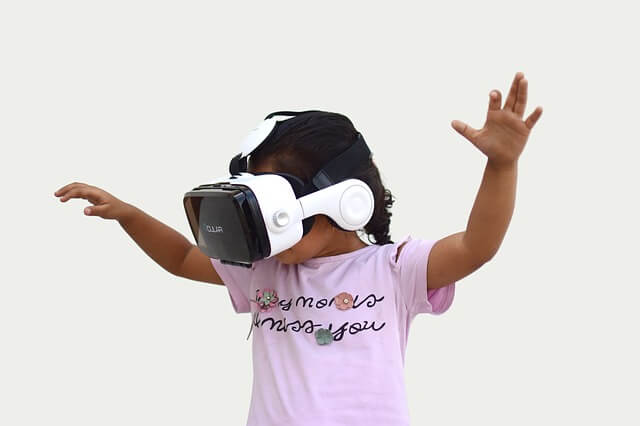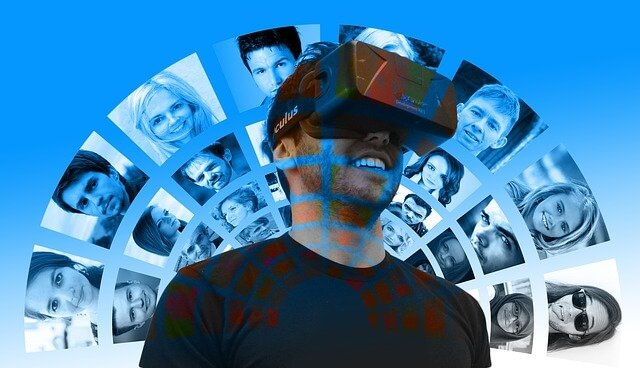Imagine a geography lecture where students can really experience the Amazon forest and all the species instead of a teacher delivering a plain boring lecture. Or an anatomy lecture where instead of listening to the long lectures having all the complicated terms you are actually visualizing the whole skeleton system or a whole organism. And to all the engineers out there, imagine using all the concepts from books and applying it on a machine via virtual reality.
You read it right, not only these scenarios but several more are possible with the use of virtual reality or augmented reality. It can be useful for virtual education tours, medical training, understanding the ancient philosophies, architecture, chemistry and much more. Both of these technologies can be used to teach a lot of things making learning interesting and interactive. Before jumping directly to the use of augmented reality and virtual reality in learning, let’s first quickly understand both of these concepts.
Virtual Reality & Augmented Reality

Technically, both have emerged from the same technology cloth but when it comes to implementation, they are far different. In similarity, both the technology consists of the 3-D element, both provide an enriched and enhanced user experience and both require some or other kind of devices. But, with the end-users, both differ when it comes to its usage.
Virtual Reality is a technology used to create a 3-D and computer-generated environment such as space, a lawn tennis court, war zone and so on. It provides a completely new environment by manipulating objects which shuts out the physical world for the users. For instance, imagine a class where instead of learning any history lessons, you are taken back in history to see all the events unfolding. However, it requires a device or a mask or a “face brick” which engineers call it to wear for having its complete experience.
In augmented reality, we superimpose information or modify the existing scenario/real-world by adding objects, sounds, images or text. Augmented reality adds different digital elements to the current user view by using the device’s camera. Its most common examples are currently seen in various mobile games such as Pokemon Go and others. You can also go through How Augmented Reality is Going to Shape The Future for further reading.
Augmented Reality and Virtual Reality in Learning
In the last few years, both of these technologies have made significant strides from just a buzz to reality. Today, these are already being used in various games or for training purposes. And experts believe that they’ll become more accessible and popular in the near future.
Among many, education can be one sector where AR and VR can become a game changer. There are several subjects and topics, which can be explained more effectively by using these technologies. They can provide a better sense of vision which can make learning interesting for all sort of students.
Why AR and VR is Important in Learning

Despite its popularity, it is yet to make its mark in the e-learning industry. However, it shows a prominent future as the investments in AR and VR are rising continuously. Below are some points which give insights into the importance of these technologies in the learning industry.
Increased Engaging
Let’s be honest, instead of understanding or learning new things, most of the students are studying just because they have to, not because they want to. Contrary to this, even the best teachers find difficulty in making learning more interesting and engaging. However, the use of AR and VR has the potential to change this trend. It can make education much more exciting than just listening in the classroom.
Fewer Distractions
Keeping students attentive throughout the class is often hard for even the most strict teachers. And thanks to smartphones, this task has become more difficult. Nevertheless, instead of fighting with these technologies, we can use it for enhancing the learning. Learning via VR prevent all the distractions keeping them attentive throughout the lecture. It helps students to remain focused on making the subject interesting.
More Teaching Options
The current way of explaining things by the teacher to the students is more or less like a throwing dart with the blindfold. Some students understand all the points while others miss it completely. Here, AR and VR can provide different approaches and possibilities for explaining all the complicated concepts in various possible ways, making it less challenging. The ability to show the real-time presentations, animations, models, 3D designs and others gives myriads of different ways to the teachers for explaining any topic.
For Further Reading: 6 Ways Augmented Reality Can Improve the Learning Experience
Different Fields where AR and VR can Impact the Learning

1. For Training
Currently, one thing which most of the students lack after graduating from college is skills for that particular field. Contrary to this, every companies and organization are in a constant search for skilled individuals. And the case with the education system is that it teaches you everything except skills.
Here VR can play an essential role in building the student’s skills. With simulation, VR can help the student learn all the necessary practical skills by presenting them with real-world scenarios without any financial or unfamiliar risks.
To support this, Google conducted an experiment on several individuals divided into two groups. They found out that the group of individuals who were trained with the VR could learn the skills more quickly and faster than the group who were just shown the video.
2. Philosophy, Architecture
Philosophy meaning “Love of Wisdom” is one of the most important disciplines for humans. Despite having its abstract nature, it helps you to question things, improve your communication or writing skills, enhances your persuasive powers, lets you understand other disciplines like science, literature or others, helps you with better researching and so on.
When it comes to learning, all its centuries-old theories, concepts, texts and others can be brought to life by using AR and VR. Imagine a scenario where you are taken to the century-old environment where you are experiencing all the events unfolding in the real-time. This improves learning by many-fold instead of learning from the books or even watching the videos.
3. Architecture
Various experts believe that employing Augmented and Virtual Reality enhances the student’s creativity and makes learning more engaging. These technologies promise countless of possibilities for students to learn architecture. Some schools and colleges are even using it for constructing 3D models of different buildings, bridges, historical sites and so on.
4. Science

Accept it, there are only a few minds who can literally understand all its concepts at once and can relate it to the real world. This doesn’t mean that these students only deserve to study science. There are several students who love this subject and can make wonders if taught in the correct way.
To tackle this, we can use AR and VR to show the 3D models of different things. These can be anything such as digestive systems, the universe, solar system, anatomy of a living organism and so on. Imagine, where your child is been shown a 3D model of the complex strand of DNA, or different parts of the circulatory system, or the skeleton system and then being told about each part, their function, importance and other essential things. It will be the experience of its own as now your child will now understand all the basics and how it works.
5. Special Education
It is another part of learning where AR and VR can bring astonishing results. There are numerous schools dedicated to students requiring special needs. Often, teaching some concepts to these students becomes difficult for even the pro teachers.
These technologies can give visual insights and audio commentary of any subject so that the children can have a better understanding. For instance, these technologies can create the environments of pyramids so that children can have better insights into it. Or can show a jet engine and its different parts for making them understand its working or principle.
6. Distance Learning
AR and VR both have a huge potential in Distance learning by improving the learning outcomes for students. It can join people together and can bring education to them regardless of their geographical locations or any other circumstances. AR and VR can even provide virtual chat spaces where these students can even raise their doubts and join the discussions by interacting with the lecturers and other students.
Final Thought

Interest, understanding, focus, imagination, interactivity are the keys for better learning. Whereas today majority of the institutions are limited to delivering lectures or notes or taking practicals. VR and AR technology provides several opportunities to these institutions and the teachers for transforming their ordinary lectures into an unforgettable experience.
Imagine, your students are learning history by virtually going into the past, standing alongside Napoleon and experiencing the Battle of Waterloo; or virtually traveling to New Zealand in order to understand the Maori Culture; or viewing how white blood cells capture and kill bacteria in real-time.
Although, these technologies are relatively new in the learning sector and still needs to be adopted by various schools, institutions and colleges, but it shows a promising future. Some companies are experimenting with their usage on a larger scale, and some schools/universities are even started using it. As of now, it may seem a fantasy or the concept from any sci-fi movies but once incorporated, it’ll be the revolutionary for both students and the teachers opening various doors of possibilities.
In order to learn to programme for the virtual reality, you can opt for A-Frame Web VR Programming Tutorial Series explaining you everything from the basics to the advanced of VR whereas, you can take Vuforia Augmented Reality course for creating amazing AR Applications.